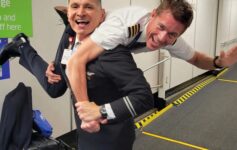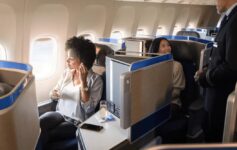
UPDATE: It appears it was a weather balloon, not an interstellar object, that struck a United Airlines 737 MAX 8 windshield, forcing a diversion to Salt Lake City.
Two days after the incident, John Dean, the CEO of WindBorne Systems speculated that one of the company’s weather balloons may have hit the United aircraft. WindBorne Systems is a technology company that uses a global constellation of long-duration weather balloons, called Global Sounding Balloons (GSBs), to collect atmospheric data and improve weather forecasting and climate change modeling. Dean explained:
Yes, I think this was a WindBorne balloon. We learned about UA1093 and the potential that it was related to one of our balloons at 11pm PT on Sunday and immediately looked into it. At 6am PT, we sent our preliminary investigation to both NTSB and FAA, and are working with both of them to investigate further.
We file NOTAMs, follow all specifications required by FAA 14 CFR part 101, and share all live balloon positions with the FAA via API and our website. The photo from Scott is old hardware, the current version operational is about 2x lighter.
WindBorne operates a constellation of long duration lightweight weather balloons to improve weather forecast, with much of our data going to both US and international governments. We have been coordinating with the FAA for the entire history of the company.
The system is designed to not pose a risk to human life in the worst case event of a collision. This is what the FAA 101 and ICAO weight limits are for. And indeed, there were no serious injuries and no depressurization event to my knowledge as a result of the collision.
However, I’m still surprised to see spallation of the windshield on the inside. I find this extremely concerning, and unacceptable in the case of a collision, regardless of what the official regulations are. It resulted in injury to a pilot, which I’m simply not okay with whatsoever.
As mentioned, we are working closely with the FAA on this. We haven’t yet received any operational guidance. Regardless, we just deployed a software change to minimize time at active flight levels and are manually checking it across the full constellation. Additionally, we are actively working on new hardware designs to reduce impact force magnitude and concentration.
While this may be the prevailing theory, the investigation is ongoing.
The original story, published on October 18, 2025, is below.
It’s not often that a cracked cockpit windshield turns into a national headline, but this one might deserve the attention. On a routine United Airlines flight from Denver to Los Angeles, a Boeing 737 MAX diverted to Salt Lake City after the front windscreen cracked mid-flight, allegedly leaving scorch marks and even a bruised pilot. Was the aircraft struck with space debris or another interstellar object?
United 737 MAX 8 Windshield Cracks At 36,000 Feet, Scorch Marks Found
The Aviation Herald flagged that United Flight 1093, operated by a Boeing 737 MAX 8 (N17327), departed Denver (DEN) on October 16, 2025 bound for Los Angeles (LAX) with 140 passengers onboard. About 30 minutes into the flight, the crew reported a cracked windshield at cruising altitude, 36,000 feet, and began descending. The jet landed safely in Salt Lake City (SLC) roughly an hour later.
At first glance, this could sound like a straightforward windshield failure, something that does happen occasionally due to manufacturing stress or temperature differentials. But this case was different: the damage showed apparent burn or scorch marks, and one of the pilots suffered bruising on his arm, consistent with a sudden jolt or partial depressurization, in an image shared by aviation-insider JonNYC.
That has fueled speculation online that an external object may have struck the aircraft, possibly a small meteor fragment or even a piece of space debris. It sounds far-fetched, but similar events have occurred before (there’s documented evidence of micrometeorites making it to the lower atmosphere).
United quickly dispatched a replacement 737 MAX 9 to take passengers onward to Los Angeles. The damaged jet was taken out of service for inspection and passeners arrived in LA about six hours late.
What Could Cause Scorch Marks On A Windshield?
Commercial aircraft windshields are built to handle enormous pressure differentials and impacts from hail or birds. They consist of multiple layers of glass and plastic laminate with embedded heating elements to prevent icing.
When those heating elements malfunction, overheating can occur. That has caused burn patterns and cracks in the past, though usually without physical injury. If that’s the case here, the scorch marks could be electrical rather than external and the bruised pilot might have been struck by fragments or startled by the loud pop such cracks can make at altitude.
The FAA and Boeing will no doubt look closely at whether electrical arcing or static discharge played a role, or if there’s evidence of an external object strike. Until the investigation concludes, all we have are alleged photos and a lot of theories.
It’s worth noting that this flight diverted safely, the pilots followed procedure perfectly, and there were no passenger injuries, though the pilot’s arm looks concerning.
CONCLUSION
We don’t yet know what caused the crack, the burn marks, or the pilot’s injury (if the images are even from UA1093) but this isn’t something that should happen on a modern jet. Whether it was electrical arcing or a small piece of debris from space, the image of a bruised pilot behind a scorched windshield at 36,000 feet is a story I hope we will soon get to the botom of.
image: JonNYC / X // hat tip: One Mile At A Time




It’s possible that this was caused by a small piece of metal from space. Unlikely, but possible.
I’m going with Starlink or Chinese spy balloon.
Probably starlink. Ironic that it hit a United plane
Elon derangement syndrome is almost as bad as TDS.
Also you never admitted you were wrong about the Charlie Kirk shooter ending up being a tranny loving lefty.
He’s a silly little bitch Walter, he’ll never admit to being a greasy lying C&ntwad
Re: “He’s a silly little … “, there you go again Sch*tt Hsuan, verifying the accuracy of your nickname.
Douchebag Dave Edwards & Sch*tt Hsuan, proving with your every (too frequent) comments that your nicknames are absolutely accurate and completely deserved and that you have nothing better to do with your pathetic waste-of-oxygen lives than to post abhorrent and revolting comments here over and over again every single day. Thank you for confirming again that you and other MAGAs are stupid hateful racist cretins. Trolling or not, the extent and frequency of your comments are indicative of severe psychiatric and/or addiction problems. Your insults, undoubtedly projection, speak much more to your lack of character than to anyone you attack. You should crawl back under whatever rocks you crawled out from you SHPOSs.
Still believing the farce that the shooter wrote messages on the shell casings telegraphing his motive? Is it painful having a smooth brain?
So, when I said ‘balloon’ above… I was onto something!
If it got hit by “space debris” that airplane would be destroyed.
If it were a very tiny piece it’s possible. It certainly looks like they hit something, but exactly what they hit is unclear. I guess we’ll have to wait until the investigation report is published.
The billionaire private rocket club fills the skys with enough cast off debris we should consider future grills to protect aircraft. Each launch increases the likelihood of a similar event.
I think it’s less “scorch mark” and more just scratches or paint transfer from impact. Obviously they hit something. Hopefully they’ll be able to determine if it was meteorite, space debris, or something ascended by balloon.
The flight deck debris and injuries indicate the shield’s multiple layers were breached. Why didn’t the aircraft depressurize?
Good question.
The force of an impact can be transmitted through the layers of lamination and shatter innermost layer, spraying the cockpit with glass fragments without causing an immediate and catastrophic breach of the structural integrity of the windshield. The crew were wise to get on the ground as quickly as possible, because a damaged windshield is a ticking time bomb with the cabin pressurized.
The force of an impact can be transmitted through the layers of lamination and shatter innermost layer, spraying the cockpit with glass fragments without causing an immediate and catastrophic breach of the structural integrity of the windshield. The crew were wise to get on the ground as quickly as possible, because a damaged windshield is a ticking time bomb with the cabin pressurized.
Note that an FAA report from 2023 (https://www.faa.gov/sites/faa.gov/files/Report_to_Congress_Reentry_Disposal_of_Satellites.pdf) estimated an annual 0.1% chance that falling space debris would cause a single global aviation casualty. That meant individual passenger risk was less than a trillion‑to‑one though projected to increase.
Dr. Güntürk Üstün
You might be interested to know, Matthew, that the half dozen comments near the top of this posting are examples of what make me less and less likely to call up your Website. I know you take pride in not policing comments, but maybe it’s time you start. The no-policing policy is just another way to absolve yourself of responsibility.
Nah, that’s a horrible idea.
Most visitors come to read Matt’s content, and maybe look at comments.
For Matt to spend countless hours micromanaging comments would be absurd, a waste of his time and talent, and more importantly it would limit the exchange of ideas within this community.
Whether it’s folks like yourself who occasionally whine about others or complain about a rare grammatical inaccuracy… that’s not how I’d spend my time, by you do you, John A.
So, you can engage or ignore. If you don’t like what someone above says, then address it with them directly.
And if you wanna attack me, I welcome it. Launch your ad hominems. Feed me. Make it spicy.
It is Matthew’s blog and he is responsible for what appears here. Some days he should be ashamed.
By you do you, 1990.
How does the pilot’s arm get that way without depressurization. To be fair, Windstream’s CEO says it did not cause a depressurization event “to his knowledge”, but is there any other scenario that allows for that kind of injury?